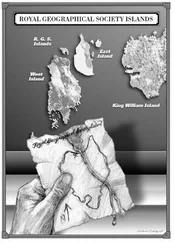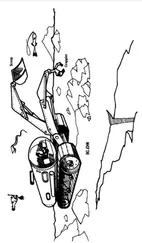The Texas was only 200 yards away when the commanders of the forts acknowledged Watkins' signal and their guns went silent one by one. Watkins and Crosby ran to the bow of the New Ironsides just in time to get a distinct look at the two men in bloodied Confederate navy uniforms and the bearded man in rumpled civilian clothes who cast a steady gaze at them and then threw a tired and solemn salute.
They stood absolutely still, knowing in shocked certainty that the sight they were witnessing would be forever etched in their minds. And despite the storm of controversy that would later rage around them, they and the hundreds of other men on the ship and those lining the walls of the forts never wavered in their absolute belief of who they saw standing amid the shambles of the Confederate ironclad that morning.
Almost a thousand men watched in helpless awe as the Texas steamed past, smoke flowing from her silent gunports, her flapping flag shredded and torn and tied to a bent railing post. Not a sound or shot was heard as she entered the enclosing fog bank and was forever lost to view.
LOST
October 10, 1931
The Southwest Sahara
Kitty Mannock had the odd feeling that she was flying head-on into nothingness. She was lost, utterly and hopelessly lost. For two hours she and her flimsy little aircraft had been knocked about the sky by a severe sandstorm that shrouded all visibility of the desert below. Alone in that empty, invisible sky, she fought off strange illusions that seemed to bloom out of the surrounding brown cloud.
Kitty tilted her head back and looked up through the upper windshield. The sun's orange glow was completely blotted out. Then, for perhaps the tenth time in as many minutes, she dropped her side window and peered over the edge of the cockpit, seeing nothing below but the vast, swirling cloud. The altimeter read 1500 feet, high enough to clear all but the most prominent sandstone plateaus of the Adrar des Iforas, an extension of the mountainous Ahaggar range of the Sahara Desert.
She trusted to her instruments to keep the plane from slipping into a spin. On four occasions since entering the blinding storm, she had noted a decrease in her altitude and an increasing change of heading, sure signs she was beginning to circle toward the ground. Alert to the danger, she had recovered each time without incident, banking until the needle inside her compass quivered back on a southerly heading of 180 degrees.
Kitty had tried to follow the Trans-Sahara motor track, but lost it soon after entering the sandstorm that rolled without warning from the southeast. Unable to see the ground, she had no idea of her drift and could not tell how far the wind had pushed her off course. She turned west, compounding her drift, in a vain attempt to fly around the storm.
She could do nothing but sit alone and plunge on across the great ocean of menacing, featureless sand. This was the stretch Kitty feared most. She calculated that she still had another 400 miles to fly before reaching Niamey, the capital of Niger. There, she would refuel before continuing her long distance record-setting dash to Cape Town in South Africa.
A weary numbness was creeping into her arms and legs. The never-ending roar of the engine's exhaust and its vibration were beginning to take their toll. Kitty had been in the air almost twenty-seven hours since taking off from the aerodrome at Croydon, a suburb of London. She had flown from the cold damp of England into the dry furnace of the Sahara.
Darkness would fall in another three hours. The unfavorable wind from the sandstorm slowed her airspeed to 90 miles an hour, 30 off the 120-mph cruising speed of her old, reliable Fairchild FC-2W, a high-wing monoplane with an enclosed cockpit and cabin, powered by a Pratt & Whitney Wasp 410-horsepower radial engine.
The four-passenger aircraft had once been owned by Pan American-Grace Airways and flew scheduled mail stops between Lima and Santiago. When it was taken off the route in favor of a more advanced model that could carry six passengers, Kitty had purchased it and installed extra gas tanks in the passenger compartment. She then proceeded to set a long-distance record from Rio de Janeiro to Madrid late in 1930, the first woman to fly the Southern Atlantic Ocean.
Another hour passed while she fought to stay on her planned compass course against the buffeting wind. Fine sand seeped into the cabin and invaded the tender membranes of her eyes and nostrils. She rubbed her eyes but merely aggravated the discomfort. Worse, she could no longer see. If she became blind and could not read her instruments, it was all over.
She pulled a small canteen of water from under her seat, uncapped it, and splashed water on her face. She felt refreshed and blinked her eyes furiously, the wet sand trickling down her cheeks and drying within seconds under the harsh heat. Her vision returned, but her eyes felt as if they had needles sticking in them.
Suddenly, she sensed something, a tiny instant in time or a sound that was out of sequence, or perhaps a slight tick of silence amid the wind and exhaust of the engine. She leaned forward and studied the instruments. Every dial showed normal. She checked the fuel cocks. Each valve was in its correct position. Finally, she wrote it off to a foggy mind.
Then the infinitesimal blip in sound came again. She tensed, all her senses tuned to her ears. The sequence between the abnormal and the normal came faster now. Her heart sank as she recognized a misfiring sparkplug in one of the engine's cylinders. Then the sparkplugs cut out one by one. The engine began to cough badly now as the tachometer needle slowly slipped backward.
A few moments later the engine stopped dead and the propeller swung still. The abrupt silence from the exhaust manifolds hit her like a shock wave. The only sound that came was the moaning rush of the wind. Kitty had no doubts. She knew absolutely why the engine had failed. The constant barrage of sand had choked off her carburetor.
The first few seconds of surprise and fear passed quickly as Kitty took stock of her limited options. If she somehow made a successful landing, she could wait out the storm and probably make repairs. The plane began to settle, and she eased the control stick forward to begin her glide to the desert below. It would not be her first dead-stick landing. She had at least seven under her belt, having crashed on two of those occasions and walked away from each with little more than a few cuts and bruises. But she had never attempted a dead-engine landing in the dim half-light of a sandstorm. Gripping the control stick tightly in one hand, Kitty pulled on a pair of goggles with the other, dropped the side window, and tilted her head out.
Down she flew, unseeing and trying desperately to imagine what the ground was like. Though she was certain most of the desert was reasonably flat, she also knew there were hidden gullies and high sand dunes waiting to smash the falling Fairchild and its female pilot. It seemed to Kitty that she aged five years before the barren terrain finally flashed into view little more than 30 feet below her undercarriage.
The ground was sandy but looked firm enough for her wheels to roll over it. But best of all, it looked invitingly smooth. She flattened her glide and touched down. The Fairchild's big tires struck, bounced twice, three times, and then rolled effortlessly through the sand as the airspeed fell off. Kitty had sucked in her breath to give a cry of joy as the tailwheel settled down, when all of a sudden the ground fell away in front of her.
The Fairchild sailed off the sharp edge of a bluff and dropped like a rock into a deep, narrow dry wash. The wheels crunched into sand and the undercarriage collapsed. The forward momentum threw the plane into the far wall of the wash in a splintering thud of collapsing spars and tearing fabric. The propeller shattered as the engine was shoved back, breaking one of Kitty's ankles and twisting her knee. She was jerked forward. Her safety straps should have held her upright, but she had forgotten to tighten the buckles and her upper body was thrown forward. Her head slammed against the frame of the windshield and she was swept into darkness.
Читать дальше












